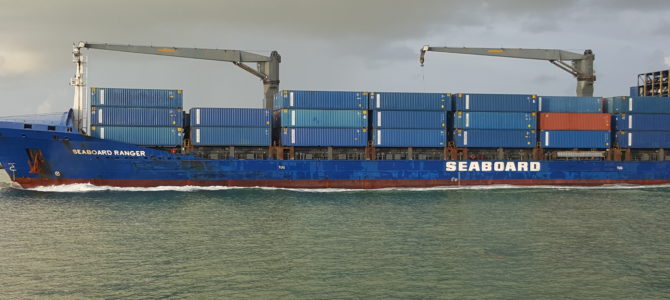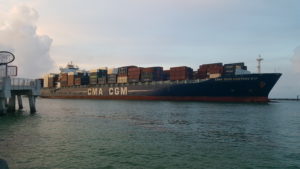Pursuant to 49 CFR 172, Subpart C, the shipper of a hazardous material (HazMat) is required to prepare a shipping paper that – unless specifically excepted by the Hazardous Material Regulations – includes the following information:
- The HazMat’s basic description [§172.202(a)(1-4)].
- Total quantity of HazMat (unless by air) [§172.202(a)(5)]. Total quantity by air is at §172.202(a)(6).
- Number and type of packages [§172.202(a)(7)].
- The HazMat’s additional description, if necessary (§172.203)
- Emergency response telephone number [§172.201(d)].
- Shipper’s certification (§172.204).
- And pursuant to §172, Subpart G, emergency response information must be immediately available for use whenever a HazMat is present in transportation.
But we’re not here to review the requirements for a HazMat Shipping paper, the purpose of this article is to identify and explain the requirements of the Dangerous Cargo Manifest when a hazardous material is transported by vessel.
purpose of this article is to identify and explain the requirements of the Dangerous Cargo Manifest when a hazardous material is transported by vessel.
First of all, the modal-specific regulations for carriage of HazMat by vessel at 49 CFR 174.24(a) forbid the transport a HazMat by vessel unless the carrier has received a shipping paper completed as required by 49 CFR 172 (see above). That means that the shipper of a hazardous material must still create a shipping paper and provide it to the carrier even though the carrier will go on to create the Dangerous Cargo Manifest.
After receiving the shipping paper from the shipper the carrier or its agents or a person they designate for the task must complete the Dangerous Cargo Manifest to retain in the vessel during transportation. The purpose of the Dangerous Cargo Manifest (aka: list or stowage plan) is to ensure that information about the HazMat aboard a vessel is readily available in a single document (LOI 00-0048). Further, the Dangerous Cargo Manifest replaces the shipping paper completed per §172 and for that reason shipping papers and packing certificates are not required to accompany HazMat shipments on a vessel (also LOI 00-0048).
The Dangerous Cargo Manifest, however, must be kept “on or near the vessel’s bridge”, except when the vessel is docked in a U.S. port. If docked in a U.S. port, the Dangerous Cargo Manifest may be kept in the vessel’s cargo office or another location designated by the vessel’s master as long as a sign is placed beside the designated holder on or near the vessel’s bridge indicating its location. Wherever it is located, the Dangerous Cargo Manifest must always be “readily accessible to emergency response and enforcement personnel” when the HazMat is in transportation.
|
Like this article? Subscribe to my Monthly Newsletter No marketing emails! |
The Dangerous Cargo Manifest must contain the following information:
- The name of the vessel and its official number. If the vessel has no official number, the international radio call sign must be used instead.
- The nationality of the vessel.
- The description of the hazardous material exactly as it appears on the shipping paper. This means the HazMat’s basic description and its additional description, if necessary (refer to §172.203(i) for the additional description required on a shipping paper when transporting HazMat by vessel). The language in the HMR at this point is rather confusing. For example, §176.30(a)(3) requires only the, “Shipping name and identification number of each hazardous material on board as listed in §172.101 of this subchapter…” And §176.30(a)(5) mandates the, “Classification of the hazardous material in accordance with either the Hazardous Materials Table, the §172.101 table; or the IMDG Code.” While §176.30(a)(6) specifically requires the additional description. The language of these regulations seem to overlap in what they request. Given the fragmented nature of the regulations (why not just require the hazardous material’s basic description?) it’s understandable that a shipper may be uncertain of what is required here. However, this letter of interpretation from USDOT/PHMSA re-affirms what is written at §176.30(b): “The hazardous material information on the dangerous cargo manifest must be the same as the information furnished by the shipper on the shipping order or other shipping paper…” The letter of interpretation (from March 2009!) goes on to state that the confusing language in §176.30(a) will be revised in an upcoming rulemaking (LOI 09-0040). NOTE: This article was reviewed and updated on October 29, 2019 and there is still no change to the confusing regulations. The one exception to this regulation is that the “correct technical name” and the class authorized for the dangerous good by the International Maritime Organization may be indicated on the Dangerous Cargo Manifest.
- An emergency response telephone number.
- Number of and description of HazMat packages, e.g. barrels, drums, cylinders, boxes, &etc.
- Gross weight for each type of packaging. It is important to note two things here:
- Gross weight means the combined weight of the HazMat and its packaging. Read more about the use of gross weight v. net weight in the HMR.
- The gross weight is required for each distinct type of packaging, not for each package nor for the shipment as a whole. Read more about the use of the terms “package” and “packaging” in the HMR.
- The stowage location of the HazMat on board the vessel. The carrier can determine this from column 10 of the Hazardous Materials Table.
|
Contact me with any questions you may have about the transportation of hazardous materials by air, highway, vessel, or rail International and Domestic Daniels Training Services 815.821.1550 |
Since no mention is made of it at §176.30, is it necessary to include the emergency response information of 49 CFR 172, Subpart G (complimentary to but not the same as the emergency response phone number)? Yes it is. Why? Because §172.600(b) defines its applicability as:
This subpart applies to persons who offer for transportation, accept for transportation, transfer or otherwise handle hazardous materials during transportation.
In other words, whenever a HazMat is subject to the HMR, emergency response information must be immediately available (LOI 00-0048, again).
If a vessel is used for the storage of a hazardous material (§176.30(a)(8) reads, “storage of explosives or other hazardous materials”. This is misleading. Conversation with USDOT/PHMSA confirms that this passage can be interpreted to mean “all hazardous materials”) the following additional information must be included on the Dangerous Cargo Manifest:
- Name and address of the vessel’s owner.
- Location of vessel’s mooring.
- Name of person in charge of vessel.
- Name and address of the owner of the cargo.
- A complete record, by time intervals of one week, of all receipts and disbursements of HazMat. The name and address of the consignor (aka: shipper) must be shown for each receipt and the name and address of the consignee (aka: receiving facility) must be shown for all disbursements.
Read more about consignor and consignee in the HMR.
Are we done? Not quite, two separate signatures certifying/acknowledging the information on the Dangerous Cargo Manifest must be present.
Certification:
The person who supervises the preparation of the Dangerous Cargo Manifest (not necessarily the person who actually prepares it) must ensure that it accurately and truthfully describes the hazardous material and shall certify this by signing his name and noting the date of preparation. No specific content is required in the HMR for this certification statement on the Dangerous Cargo Manifest as it is for the shipping paper, so it could look like one of the certification statements at §172.204 (Read about the certification statement on the HazMat shipping paper), or – borrowing language from §176.30(b) – it could look like this:
This is to certify that I have supervised the preparation of this document and that the information related to the hazardous materials identified on it have been correctly transcribed from the shipping paper truthfully and accurately to the best of my knowledge and belief.
The carrier and its agents must ensure that one of the following persons acknowledges the correctness of the entire Dangerous Cargo Manifest (not just the description of the hazardous material) by his signature:
- The vessel’s master.
- A licensed deck officer designated by the master and attached to the vessel.
- Or if a barge, the person in charge of the barge.
Once again, no specific text for the acknowledgement is included in the regulations, so you can make up your own. Here’s a suggestion:
I am the vessel’s master, a licensed deck officer designated by the master and attached to the vessel, or the person in charge of a barge transporting a hazardous material. I hereby acknowledge the correctness of this dangerous cargo manifest, list, or stowage plan.
Use of a typewriter, word processor, or computer/printer to produce the signature(s) satisfies the requirement as long as the signature is made after the information is entered on the Dangerous Cargo Manifest (LOI 01-0284).
Note that ‘acknowledging the correctness’ of the Dangerous Cargo Manifest is not the same level of responsibility as ‘certifying the accuracy and truth’ of the hazardous material description.
The carrier of a HazMat by vessel must retain a copy of the Dangerous Cargo Manifest for at least one year and shall make it available in the event of an inspection.
Similarly, §176.24(b) requires the carrier to retain a copy of the shipping paper for one year after it accepted it from the shipper.
The following special requirements apply to a barge (manned or unmanned) transporting HazMat in addition to those described above:
- Manned barge: the person in charge of the barge shall prepare the Dangerous Cargo Manifest.
- Unmanned barge: the person responsible for loading the barge is responsible for the Dangerous Cargo Manifest and must designate an individual for its completion.
- All barges (manned or unmanned):
- the Dangerous Cargo Manifest must be on board the barge in a readily accessible location.
- a copy of the Dangerous Cargo Manifest must be furnished to the person in charge of the towing vessel.
One final note about the Dangerous Cargo Manifest: Only a hazardous material subject to the Hazardous Material Regulations of the USDOT/PHMSA or a Dangerous Good subject to the Dangerous Goods Code of the International Maritime Organization may be included on the Dangerous Cargo Manifest. No material that is not a HazMat or a Dangerous Good may be included on the Dangerous Cargo Manifest.
|
Contact me with any questions you may have about the transportation of hazardous materials by air, highway, vessel, or rail International and Domestic Daniels Training Services 815.821.1550 |
There you have it: The Dangerous Cargo Manifest. A document that must be completed by the carrier and takes the place of the HazMat shipping paper on a vessel when in transportation. The transportation of a HazMat by vessel adds extra levels of responsibility to compliance. Make sure you’re in compliance with the Hazardous Material Regulations of the Pipeline and Hazardous Materials Safety Administration of the USDOT and/or the Dangerous Goods Code of the International Maritime Organization when you offer for transport or transport a hazardous material.

